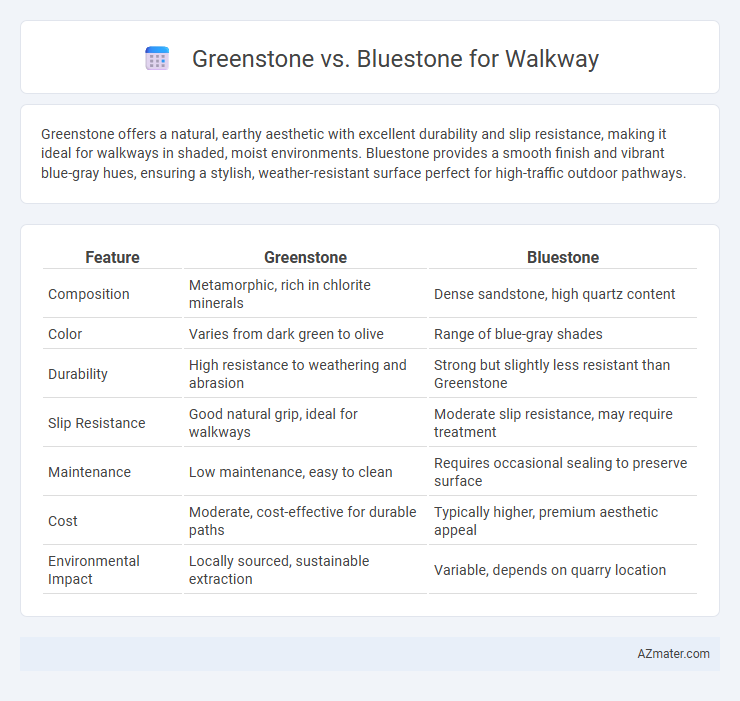Greenstone offers a natural, earthy aesthetic with excellent durability and slip resistance, making it ideal for walkways in shaded, moist environments. Bluestone provides a smooth finish and vibrant blue-gray hues, ensuring a stylish, weather-resistant surface perfect for high-traffic outdoor pathways.
Table of Comparison
| Feature | Greenstone | Bluestone |
|---|---|---|
| Composition | Metamorphic, rich in chlorite minerals | Dense sandstone, high quartz content |
| Color | Varies from dark green to olive | Range of blue-gray shades |
| Durability | High resistance to weathering and abrasion | Strong but slightly less resistant than Greenstone |
| Slip Resistance | Good natural grip, ideal for walkways | Moderate slip resistance, may require treatment |
| Maintenance | Low maintenance, easy to clean | Requires occasional sealing to preserve surface |
| Cost | Moderate, cost-effective for durable paths | Typically higher, premium aesthetic appeal |
| Environmental Impact | Locally sourced, sustainable extraction | Variable, depends on quarry location |
Introduction to Greenstone and Bluestone Walkways
Greenstone and Bluestone are popular choices for walkways due to their durability and aesthetic appeal. Greenstone features a rich, earthy green hue with subtle veining, providing a natural and elegant look ideal for garden paths and outdoor spaces. Bluestone is known for its dense texture and blue-gray coloration, offering slip resistance and versatility in both traditional and modern walkway designs.
Composition and Appearance: Greenstone vs Bluestone
Greenstone is primarily composed of metamorphosed basalt, giving it a dense, durable structure with a rich green-gray color and a slightly rough texture. Bluestone, on the other hand, is a sedimentary sandstone predominantly made of quartz and feldspar, characterized by its smooth surface and blue-gray to purple hues. The distinct mineral composition in Greenstone results in more earthy tones with a natural, rugged appearance, while Bluestone offers a softer, more uniform look ideal for elegant walkways.
Durability and Longevity Comparison
Greenstone offers exceptional durability due to its dense, fine-grained composition, making it highly resistant to chipping and weathering for walkways. Bluestone, known for its medium hardness and natural cleft surface, provides moderate longevity but may require more maintenance to prevent erosion and surface wear. In terms of long-term performance, greenstone typically outlasts bluestone in high-traffic outdoor paths due to superior hardness and minimal porosity.
Slip-Resistance and Safety Features
Greenstone offers superior slip resistance for walkways due to its natural textured surface, reducing the risk of slips and falls even in wet conditions. Bluestone, while also durable, tends to have a smoother finish that may require additional treatments or coatings to enhance safety on walkways. Both stones provide excellent durability, but Greenstone is often preferred for environments where slip-resistance and safety are top priorities.
Installation Process and Techniques
Greenstone walkways require skilled cutting and fitting due to their natural variation in thickness and texture, often involving dry-set installation with gravel or sand base for stability and drainage. Bluestone, known for its uniform thickness and smooth surface, enables easier installation using mortar or adhesive on a solid substrate, providing a more stable and long-lasting walkway. Both stones demand precise leveling and spacing, but Bluestone's consistency reduces installation time and complexity compared to Greenstone.
Maintenance Requirements for Each Stone
Greenstone walkways require minimal maintenance due to their dense composition, which resists staining and weathering, making them ideal for high-traffic areas. Bluestone, while durable, demands more frequent sealing and cleaning to prevent surface erosion and discoloration caused by exposure to moisture and outdoor elements. Proper upkeep of Bluestone includes regular sweeping and occasional resealing every 1-2 years to maintain its aesthetic appeal and structural integrity.
Cost Analysis: Greenstone vs Bluestone
Greenstone walkways typically cost between $8 to $15 per square foot, offering a budget-friendly option with durable, natural aesthetics. Bluestone prices range from $12 to $20 per square foot, reflecting its higher density and popularity in premium landscaping projects. The overall cost difference includes installation complexity, with Bluestone requiring more labor-intensive cutting and fitting compared to Greenstone.
Climate Suitability and Weather Resistance
Greenstone offers excellent climate suitability for regions with high humidity and heavy rainfall due to its dense composition and natural weather resistance, preventing erosion and surface wear. Bluestone, favored in colder climates, demonstrates superior frost resistance and durability against freeze-thaw cycles, making it ideal for areas with harsh winters. Both stones provide robust options for walkways, but selecting between Greenstone and Bluestone depends on local weather patterns and long-term exposure to moisture or freezing temperatures.
Eco-Friendliness and Sourcing Options
Greenstone offers sustainable sourcing options with quarried slabs that minimize environmental impact through local extraction and low energy processing. Bluestone, while durable and aesthetically pleasing, often involves more extensive quarrying with higher carbon emissions and less emphasis on eco-friendly practices. Choosing Greenstone for walkways supports greener landscapes by prioritizing renewable materials and reducing transportation footprints.
Which Stone Is Best for Your Walkway?
Greenstone offers a rich, natural green hue with excellent durability and slip resistance, making it ideal for walkways exposed to varying weather conditions. Bluestone, characterized by its elegant blue-gray shade and fine-grained texture, provides a smooth surface that complements modern landscapes while offering strong wear resistance. Choosing between Greenstone and Bluestone depends on your aesthetic preference and the specific climate, with Greenstone excelling in rougher environments and Bluestone favored for sophisticated, urban settings.

Infographic: Greenstone vs Bluestone for Walkway
 azmater.com
azmater.com